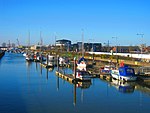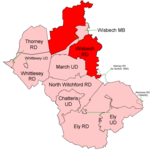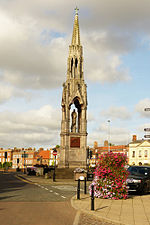Wisbech North railway station
1866 establishments in England1959 disestablishments in EnglandDisused railway stations in CambridgeshireEast of England railway station stubsFormer Midland and Great Northern Joint Railway stations ... and 5 more
Pages with no open date in Infobox stationRailway stations in Great Britain closed in 1959Railway stations in Great Britain opened in 1866Use British English from January 2017Wisbech

Wisbech North railway station was a station serving the town of Wisbech, Cambridgeshire. It was part of the Midland and Great Northern Joint Railway and was one of two stations serving the town. The other was Wisbech East on the line from March to Watlington also known as the Bramley Line. Wisbech North station was located just off Harecroft Road near a small housing estate called "Cricketers Way".
Excerpt from the Wikipedia article Wisbech North railway station (License: CC BY-SA 3.0, Authors, Images).Wisbech North railway station
Cricketers Way, Fenland District
Geographical coordinates (GPS) Address External links Nearby Places Show on map
Geographical coordinates (GPS)
| Latitude | Longitude |
|---|---|
| N 52.6694 ° | E 0.1499 ° |
Address
Wisbech North
Cricketers Way
PE13 1RN Fenland District
England, United Kingdom
Open on Google Maps








